Understanding VVS Stones: A Comprehensive Guide
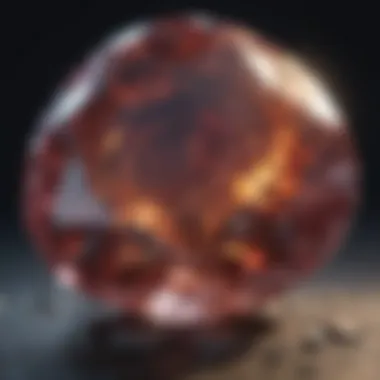
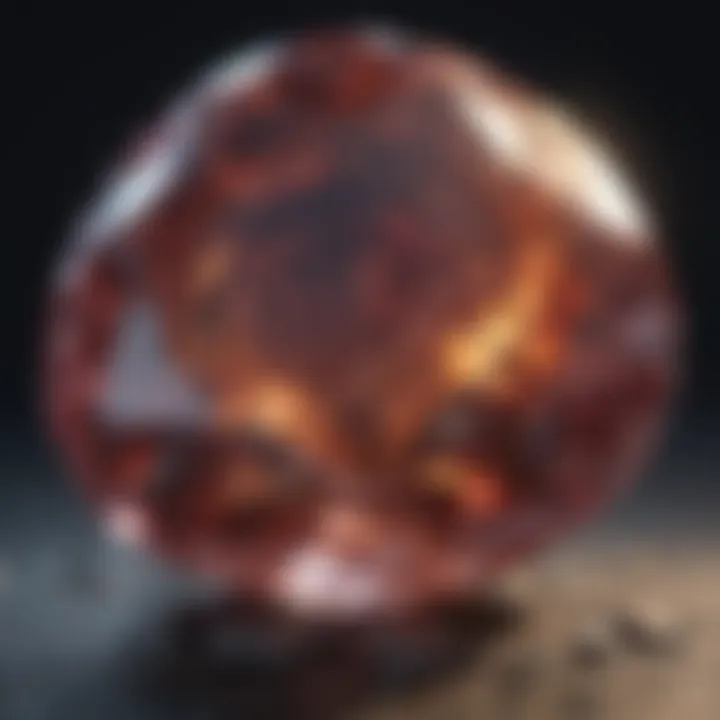
Intro
The fascinating world of gemstones stretches far beyond mere aesthetics. It is a realm where geology, culture, and artistry intersect. Among various types of gemstones, VVS stones, noted for their clarity and exquisite beauty, hold a significant place. Understanding their attributes, valuation, and implications in jewelry is essential for enthusiasts, collectors, and designers. This guide aims to provide a thorough insight into VVS stones, making it a valuable resource for those deeply invested in the world of gems.
Gemstone Overview
Definition of Gemstones
Gemstones are precious or semi-precious minerals that are cut and polished for use in jewelry and ornamentation. These stones are often valued based on their rarity, beauty, and durability. Their characteristics, including color, clarity, cut, and carat weight, play crucial roles in defining their quality and worth. VVS stones are a specific grading within this larger gemstone category, recognized for their clarity that almost reaches perfection.
Classification of Gemstones
Gemstones can generally be classified into two categories: precious and semi-precious. Precious gemstones include diamonds, sapphires, rubies, and emeralds, typically commanding higher market values due to their rarity and desirability. On the other hand, semi-precious stones, such as amethysts and topazes, offer beauty at more accessible prices. Furthermore, gemstones are graded based on several attributes, including:
- Color: The hue exhibited by the stone, impacting its appeal.
- Clarity: Presence of inclusions or blemishes; VVS stones have few to no visible imperfections.
- Cut: The craftsmanship of the stone, influencing its sparkle and shape.
- Carat weight: The size of the gemstone, often determining its market value.
"The clarity of a gemstone significantly affects its brilliance and overall appeal."
Historical Significance
Origins of Gemstone Use
The use of gemstones dates back thousands of years, encompassing functionality, adornment, and even spiritual significance. Early civilizations utilized stones not just for decoration, but also for amulets and talismans, believing in their protective qualities. Throughout history, gemstones have been associated with power and status, significantly influencing cultures around the globe.
Cultural Insights: Gemstones in Ancient Civilizations
Numerous ancient civilizations revered gemstones. For example, the Egyptians adorned their Pharaohs with lapis lazuli and turquoise, believing these stones conveyed properties that could assist in the afterlife. Similarly, in ancient India, gemstones were integral to astrology and were believed to impact an individual's fate. Understanding these cultural imperatives enriches our appreciation of VVS stones, placing them within a wider historical context that reflects humanity's continuous attraction to these natural wonders.
The journey through the world of VVS stones warrants careful examination of their grading, value factors, and practical applications within the jewelry space. This comprehensive guide will elucidate each of these components, fostering a deeper understanding for both new enthusiasts and seasoned collectors.
Intro to VVS Stones
In the realm of gemstones, understanding the nuances of clarity grades is essential for both collectors and enthusiasts. VVS stones, classified as "Very Very Slightly Included," sit near the pinnacle of gemstone clarity. This classification represents a critical intersection of beauty, value, and rarity. By grasping the concept of VVS stones, one unlocks insights into their significance in the jewelry market, enhancing appreciation for the craftsmanship and the natural wonder behind each stone.
Defining VVS Stones
VVS stones are characterized by their clarity, specifically in the context of gemstone grading systems. To be classified as VVS, a gemstone must contain only minute internal or external imperfections that are extremely difficult to detect, even under magnification. The grading system often categorizes stones in descending order of clarity: Flawless, Internally Flawless, VVS1, VVS2, and so on. VVS stones are considered among the finest, attracting a premium due to their exceptional optical properties and aesthetic appeal.
Historical Context
The classification of gemstones has a long history, dating back centuries. Yet, the formalization of clarity grading, including the VVS designation, gained prominence in the late 20th century with advancements in gemology. Early gem traders relied on visual assessments and personal expertise, often leading to subjective valuations. As the industry matured, standardized grading systems emerged, providing transparency and consistency.
The establishment of organizations, such as the Gemological Institute of America (GIA), played a significant role in reinforcing these standards. With scientific techniques in evaluating clarity, the distinction of VVS became widely accepted, ensuring that buyers and sellers alike had a clear understanding of gemstone quality. This historical evolution reflects the growing sophistication within the gemstone market, where informed decisions are paramount.
Understanding the Grading System
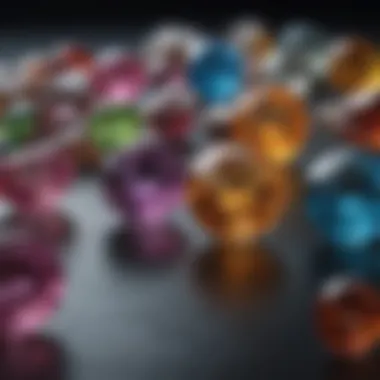
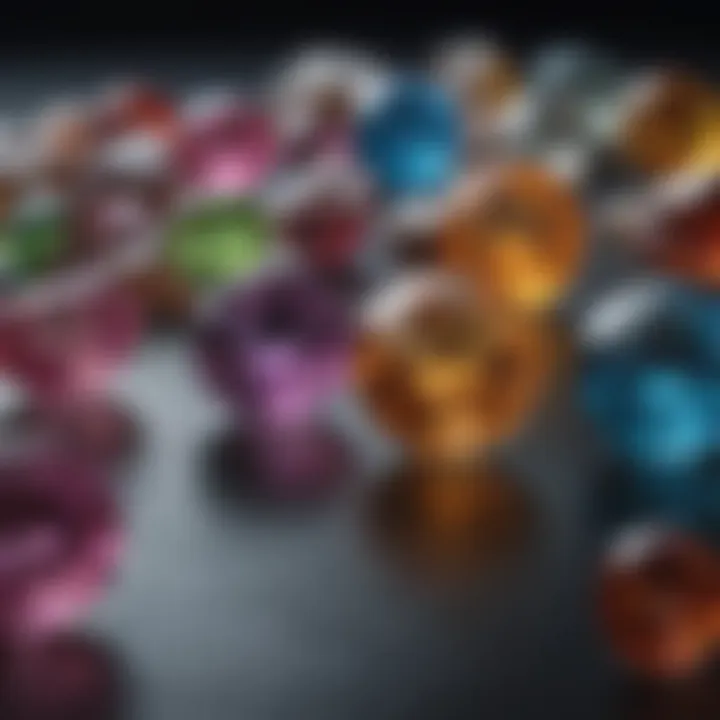
Grading gemstones is essential for understanding their quality, value, and marketability. For VVS stones, the grading system serves as a standardized method for evaluating clarity, color, and other features. This framework helps buyers make informed decisions and ensures consistency across the industry. Without a proper grading system, a consumer might struggle to understand the true worth of a VVS stone. The implications of this system stretch beyond individual purchases; they influence market trends and collector interest as well.
Gemstone Classification
Gemstones are typically classified based on their physical and chemical properties. The primary categories include precious and semi-precious stones. Precious stones—such as diamonds, rubies, sapphires, and emeralds—are highly esteemed due to their rarity and beauty. In contrast, semi-precious stones encompass a broader spectrum, including various minerals and varieties of the precious stones.
In the context of VVS stones, they generally fall under the precious category. Classification also involves the grading of clarity, which directly influences the classification. Clarity grades assess the visibility of inclusions and blemishes under magnification. Understanding classification is crucial for gemstone enthusiasts because it sets the foundation for evaluating quality and value.
Grades Explained
The grading system for gemstones includes several categories: Flawless (F), Very Very Slightly Included (VVS), Very Slightly Included (VS), Slightly Included (SI), and Included (I). VVS stones are relatively exceptional, as they contain minimal inclusions that are difficult to detect even under 10x magnification. This quality elevates their appeal within gemological circles, attracting attention from collectors and jewelry designers alike.
Each grade plays a significant role in determining a stone's market value. For example, an F-grade diamond will command a much higher price than a VVS stone, yet the latter still reflects notable quality. Recognizing the nuances in these classifications enhances one’s appreciation for gemstones, and fosters a deeper understanding of their value trajectory.
What VVS Means
VVS stands for Very Very Slightly Included. This designation indicates that while the gemstone may possess tiny inclusions, they are nearly imperceptible. The defining feature of VVS stones is that these imperfections do not detract significantly from their aesthetic appeal or structural integrity. In many cases, a trained eye or specific tools are needed to identify these minute flaws.
Furthermore, VVS stones are regarded as premium quality, thus appealing to discerning buyers. They serve as an ideal choice for those seeking a blend of beauty and value. Employing the term VVS in descriptions not only highlights the quality but also reinforces the gemstone's desirability in various markets. Overall, grasping what VVS means enriches one’s knowledge and aids buyers in making educated choices when selecting gemstones.
Key Characteristics of VVS Stones
Understanding the key characteristics of VVS stones is essential for anyone interested in gemstones. These qualities not only define the aesthetic appeal of the stones but also significantly impact their value and desirability in the market. VVS stands for "Very Very Slightly Included," a term from the grading scale for clarity. Therefore, clarity, color, cut quality, and carat weight are the primary attributes that potential buyers should consider.
Clarity and Imperfections
Clarity is one of the most important aspects of VVS stones. It refers to the presence or absence of internal or external flaws. VVS stones exhibit minimal imperfections, which are barely noticeable even under 10x magnification. This high level of clarity is what makes them precious.
Some typical inclusions found in gemstones are bubbles, feathers, or crystals. A VVS stone might contain such inclusions, but they will not distract from its overall beauty. The concept of clarity often demands a refined understanding, especially for collectors and jewelry designers looking for high-quality stones.
Inclusions can affect a stone’s brilliance and how it catches light. A higher clarity grade usually results in a higher market value, making it vital for buyers. For anyone considering a purchase, assessing clarity should be the first step.
Color and Cut Quality
The color of a VVS stone can range widely, depending on the type of gemstone. For instance, diamonds are often graded on a color scale from D (colorless) to Z (light yellow or brown). The most sought-after colors have a balance of hue, saturation, and tone.
Cut quality is equally important. A well-cut stone maximizes its brilliance and sparkle. Light must enter and reflect in a way that enhances the stone's natural beauty. The cut determines how light interacts with the gemstone, affecting its overall appearance.
While a VVS stone might excel in clarity, if it is poorly cut, it may not display the brilliance that collectors look for. Therefore, both color and cut play significant roles in determining a stone’s overall appeal.
Carat Weight Considerations
When discussing VVS stones, carat weight cannot be overlooked. Carat weight measures the size of the gemstone. Larger stones are generally more valuable, especially when they maintain high clarity and color quality. However, weight alone does not define a stone's value.
For example, a smaller VVS stone with exceptional clarity and color may surpass a larger stone with noticeable inclusions or poor color. Therefore, it’s crucial to evaluate all characteristics in conjunction rather than focusing solely on size.
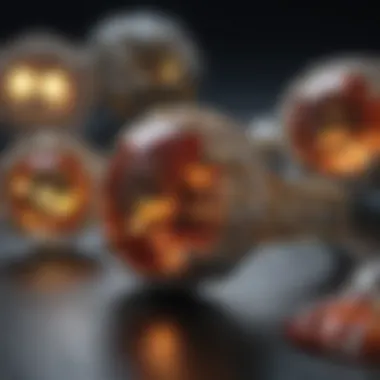

Market Value and Demand for VVS Stones
Understanding the market value and demand for VVS stones is crucial for anyone interested in gemstones. The significance of VVS stones in the market is due to their superior clarity and aesthetic appeal. They are highly sought after by collectors and jewelers alike. This section explores the multifaceted aspects that affect the market dynamics of VVS stones.
Factors Influencing Price
Several factors influence the price of VVS stones. These include:
- Clarity: VVS stones are known for their superior clarity, which means they have very small imperfections that are hard to detect. This clarity significantly increases their market value.
- Carat Weight: The larger the stone, the higher the price. Buyers often pay a premium for larger carat weights, making size a critical consideration in valuation.
- Color: The color grade of a VVS stone can heavily impact its price. Stones with rare colors often attract higher prices.
- Cut Quality: The way a stone is cut impacts its brilliance and overall appearance. Well-cut VVS stones are valued more highly for their ability to reflect light beautifully.
- Market Demand: Fluctuations in market demand can drive prices up or down. Factors like fashion trends and consumer preferences play a role.
Market Trends
Market trends for VVS stones show a consistently rising demand. Interest in gemstones, particularly in VVS stones, has increased greatly, particularly in high-end jewelry markets. The rise of online marketplaces has made it easier for buyers to find and purchase these stones. Additionally, the impact of social media influences consumer awareness and desire.
"Quality and rarity determine the market dynamics of VVS stones, making them a wise investment and treasured collectible."
Reasons for this growing trend include an increased focus on sustainability and ethically sourced gemstones. Consumers are becoming more educated about the origins of their jewelry. They prefer stones that are ethically mined and have a transparent supply chain. This shift contributes positively to the demand for VVS stones that meet these criteria.
Applications of VVS Stones in Jewelry
VVS stones play a significant role in the jewelry domain, prized for their clarity and overall appearance. These gemstones are often chosen not only for their aesthetic appeal but also for their ability to retain value over time. Jewelry designers and collectors alike look to VVS stones to enhance the visual palette of their creations. The demand for such stones is driven by the high standards of quality they represent, making them suitable for various types of jewelry items.
Types of Jewelry Featuring VVS Stones
Rings
Rings featuring VVS stones are particularly notable. They are often viewed as a symbol of commitment and celebration. The clarity of these stones allows for greater brilliance, drawing attention to the wearer's hand. Some VVS rings are custom-designed, ensuring a unique piece tailored to the individual. The main characteristic of VVS rings is their ability to reflect light effectively. This feature makes them a popular choice for engagement and wedding rings. However, the price can be a disadvantage; high-quality VVS stones command a premium, potentially making them less accessible for some buyers.
Necklaces
Necklaces that incorporate VVS stones are also highly sought after. The choice of VVS stones in necklaces adds an element of sophistication. The main appeal is the way the stones catch and disperse light while worn, creating an eye-catching effect. A unique feature of VVS necklaces is their versatility; they can be worn both for formal occasions or more casual settings. This adaptability makes them an essential addition to many jewelry collections. However, concerned buyers should note the necessity of proper care to avoid damage to the stones, especially if they are set in delicate frameworks.
Earrings
Earrings adorned with VVS stones are a classic choice for many, offering elegance and refinement. They stand out due to the clarity, providing a perfect balance with various outfits. The prominent characteristic of VVS earrings is their ability to harmonize with both simple and intricate styles, making them a staple piece in jewelry collections. However, caring for VVS earrings is critical since their settings can be vulnerable to wear. This means that while VVS earrings can enhance one's image, they also require diligent care to maintain their original beauty.
Custom Designs and Inspirations
The opportunity for custom designs with VVS stones adds further allure to these stones in the jewelry market. Custom pieces allow the wearer to express individuality and uniqueness. From asymmetrical designs to intricate patterns, custom VVS jewelry can be crafted to reflect personal style. Many designers draw inspiration from nature, geometric shapes, or even cultural artifacts, resulting in one-of-a-kind creations. Customization also provides an avenue for incorporating sentimental value into pieces, making VVS stones even more meaningful for the wearer.
Care and Maintenance of VVS Stones
Caring for VVS stones is essential for maintaining their beauty and value. These stones are prized for their clarity and brilliance. Proper care ensures that they retain these qualities over time. As a gemstone enthusiast or collector, understanding how to maintain your VVS stones contributes to their longevity and visual appeal. This section covers two primary aspects: cleaning techniques and storage recommendations.
Cleaning Techniques
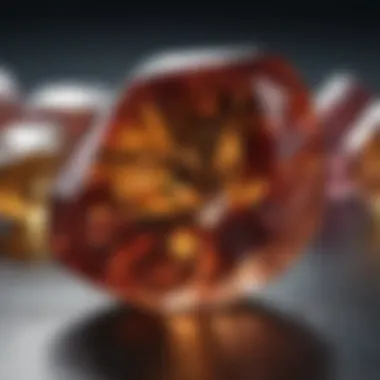

Routine cleaning of VVS stones is crucial to prevent dirt and oil buildup, which can dull their shine. Here are some effective techniques:
- Use Mild Soap and Water: This is the simplest method. Mix a few drops of mild dish soap with warm water and soak the stone for a short time. Use a soft brush to gently scrub through any crevices.
- Avoid Harsh Chemicals: Stay away from strong detergents, bleach, or abrasive cleaners. These substances can damage the stone's surface.
- Ultrasonic Cleaners: Many jewelers use ultrasonic cleaners, but caution is needed. Check if your specific VVS stone can withstand ultrasonic waves without damage. Always consult a professional if unsure.
- Dry Softly: After cleaning, use a lint-free cloth to dry the stone. Do not use rough materials, as they may scratch the stone's surface.
Proper cleaning techniques protect the integrity of VVS stones, ensuring they shine brilliantly.
Storage Recommendations
Storing VVS stones correctly plays a significant role in their maintenance. Poor storage can lead to scratches or other damage. Consider the following storage tips:
- Use Separate Compartments: Avoid storing multiple stones in the same space. Use a jewelry box with individual compartments to prevent stones from scratching each other.
- Soft Pouches or Wrapping: When not being displayed or worn, wrap each stone in a soft cloth or place it in a padded pouch. This adds a layer of protection from potential damage.
- Controlled Environment: Store VVS stones in a cool, dry place. Extreme temperature changes and high humidity can affect their quality.
- Avoid Exposure to Direct Sunlight: Prolonged exposure can fade the color of some gemstones. Keep stones out of direct sunlight when storing them.
In summary, proper care and maintenance of VVS stones include effective cleaning methods and smart storage practices. By following these guidelines, collectors and enthusiasts can preserve the beauty and clarity that defines VVS stones.
Ethical Considerations in Sourcing VVS Stones
Ethical considerations are increasingly pertinent in the world of gemstones, including VVS stones. As consumers become more conscious about the origins of their purchases, understanding the implications of sourcing these stones is essential. The journey of VVS stones from mine to market involves various factors that can impact environmental sustainability and social responsibility.
The Importance of Ethical Sourcing
Ethical sourcing refers to the practice of ensuring that materials are obtained in a responsible and sustainable manner. This concept holds significant weight for VVS stones, as many consumers prioritize stones that do not contribute to human rights abuses or environmental damage. Ethical sourcing helps protect local communities, as well as ensuring that workers are treated fairly. By choosing ethically sourced stones, buyers can promote responsible mining practices that safeguard the rights of workers.
The demand for ethically sourced VVS stones is growing. This change is largely driven by consumer awareness and a desire to make informed choices. For many, the quality of the stone is intrinsically linked to its sourced integrity. Those interested in high-quality gemstones can feel confident that their purchases align with their values, showcasing a commitment to ethical practices.
Sustainable Practices
Sustainable practices in gemstone sourcing focus on minimizing environmental impact while ensuring the welfare of communities involved in the mining process. VVS stones can be sourced through methods that mitigate ecological damage. Ethical mining operations often adopt practices such as recycling water and minimizing land disturbance. Such approaches help preserve ecosystems and promote biodiversity.
Additionally, organizations can work towards improving the livelihoods of those within the mining communities. This could involve providing education, fair wages, and supporting local economies. Companies might also engage in responsible sourcing certifications to indicate their commitment to these sustainable practices.
In summary, ethical considerations in sourcing VVS stones serve both moral and practical functions. For enthusiasts, collectors, and designers, understanding these elements can enhance the appreciation for VVS stones. They are not just beautiful objects; they also represent a deeper commitment to ethical and sustainable practices in the gemstone industry.
Epilogue on VVS Stones
The exploration of VVS stones reveals substantial insights into both their intrinsic and extrinsic values. This conclusion emphasizes the importance of understanding their unique characteristics, grading, and market dynamics. VVS stones sit at the crossroads of quality and demand in the gemstone industry, making them not just aesthetically pleasing but also a significant investment. These stones often reflect the high standards expected by collectors and designers, which can be attributed to their clarity and brilliance.
Summarization of Key Points
In this article, several pivotal aspects regarding VVS stones have been discussed:
- Definition and Historical Context: We defined VVS stones, traced their historical significance, and their place in the beauty of gemstones.
- Grading System: The grading practices, especially the nuances between different grades, help in understanding the marketplace better.
- Key Characteristics: From clarity to carats, we detailed how each characteristic contributes to the overall value and appeal of VVS stones.
- Market Value and Demand: Factors influencing the price and emerging market trends were analyzed to grasp the economic landscape surrounding VVS stones.
- Jewelry Applications: An overview of various jewelry types featuring VVS stones and how they are incorporated into custom designs.
- Care and Maintenance: We also covered best practices for cleaning and storing these valuable stones to ensure their longevity.
- Ethical Considerations: Finally, the importance of ethical sourcing is crucial in building sustainable practices within the gemstone industry.
Future Trends and Insights
Moving forward, the outlook for VVS stones is promising. As appreciation for ethical practices grows, there will be more emphasis on sourcing VVS stones responsibly. This could lead to increased market stability and consumer trust. Additionally, technological advancements in gemstone evaluation may enhance grading precision, further influencing buyer confidence.
Moreover, trends indicate that jewelry designers are likely to focus more on custom, unique pieces using VVS stones, appealing to consumers' desires for individuality. This shift can create a dynamic landscape for VVS stones, influencing their desirability and market presence.
The ongoing dialogue about sustainability in jewelry design will also likely enhance the value proposition of VVS stones, as consumers become increasingly conscientious about their purchasing decisions. In the future, VVS stones may not only represent luxury but also a commitment to ethical practices and quality craftsmanship.
"Understanding the multifaceted nature of VVS stones not only enhances appreciation but also empowers informed choices among gemstone enthusiasts and collectors."



